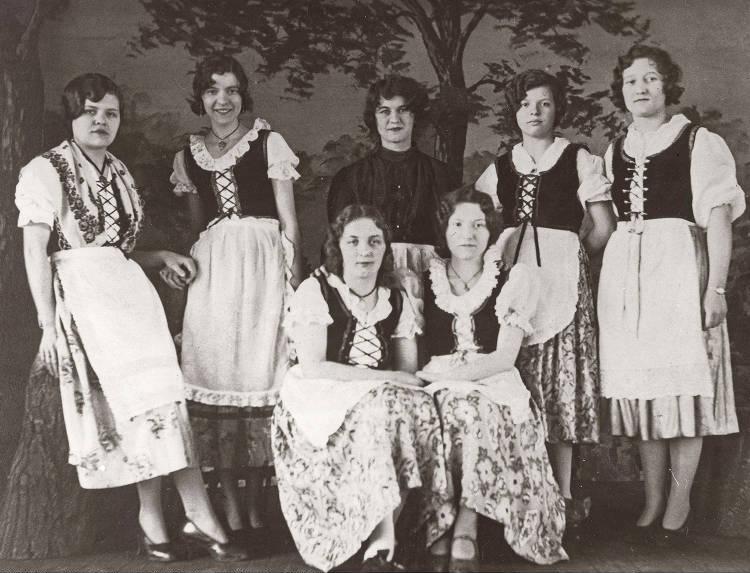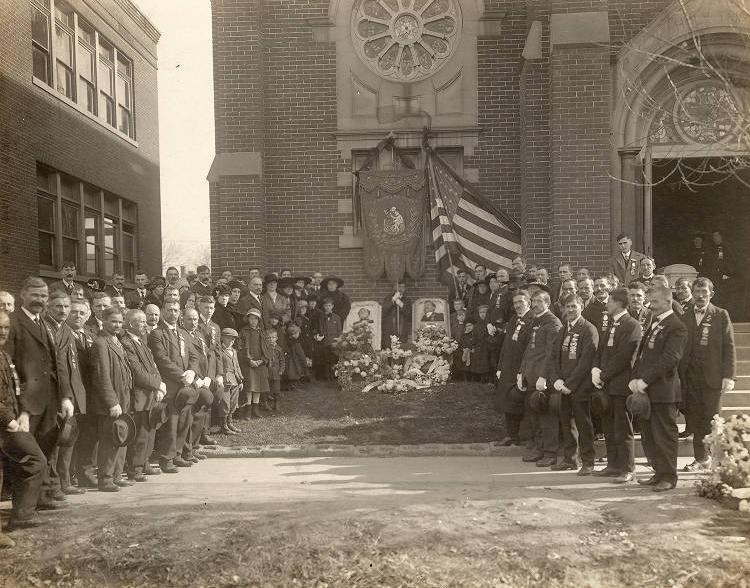The first recorded Slovene in Indiana settled at New Alsace in Dearborn County in the early 1830s. Not until decades later, in the 1890s, did Slovenian immigrants from the Habsburg Austrian provinces of Carniola, Styria, Carinthia, and the Littoral arrive in Indianapolis. They lived primarily in the industrial suburb of bounded by 10th , Holmes, Michigan, and Haugh streets.

George Lambert (Juri Lampert), a Slovenian immigrant from Besnica, recruited fellow countrymen to work for the National Malleable Castings Company, a Cleveland-based firm that operated a foundry on the northwest corner of Michigan Street and Holmes Avenue. They also found employment at meatpackers, , and other local factories.
By the 1930s, some Slovenian residents sought to escape the drudgery of the factory or housing boarders by farming along the Morgan-Brown county line. Others operated their own businesses, such as bakery (Dezelan), dry goods (Koren), hardware (Urbancic), saloon (Gasnik, Turk, Milharcic), tailoring (Urajner), and grocery (Bucar, Fon, Zeunik, Matelko), which sustained the local community.
By World War I, the Slovenian community (of approximately 1,200 individuals) was sufficiently numerous to organize several supporting institutions. Mutual aid societies provided members with income during sickness and their families’ benefits in case of a member’s death.
The first society was St. Aloysius Lodge (1900), followed by St. Joseph Lodge and the socialist-oriented Franc Preseren Lodge (1905). Members’ attitudes toward religion distinguished one lodge from another. The popular quip was that St. Aloysius members always prayed, St. Joseph members frequently prayed, but Preseren members never prayed.

In 1918, over 400 stockholders organized the . The facility, which served as a social center, meeting place, and theater, moved to its present location at 10th Street and Warman Avenue in 1940.
Because of disagreements with the local Irish-American pastor, St. Aloysius and St. Joseph lodges agitated and raised funds for a separate Slovenian parish. Bishop Francis Silas Marean Chatard reluctantly agreed to organize Holy Trinity as a national parish in 1906 with Father Joseph Lavric as its first pastor. (A national parish is a type of Catholic parish distinguished by liturgical rites or nationality of the congregation.) In 1948, Holy Trinity ceased being a national parish and opened membership to all neighborhood Catholics, producing a peak membership of 2,250 in 1956.
In 1907, Slovenian individuals attended the dedication of the present brick and stone church on the corner of Holmes Avenue and St. Clair Street. Between 1906 and 1919, over 1,000 infants were baptized there. The parish school, founded in 1911, had 434 pupils by 1923. Continued growth led to the construction of a new school-social hall in 1927.
Besides the church, community life featured numerous athletic activities. Slovenian residents were especially adept at playing “kick the wicket” and team sports. In 1936, the West Side Jugoslav Football Team was the undefeated city league champion. Three years later, Indianapolis hosted a national Slovenian athletic meet.
The high point of Slovenian immigration came in the two decades before World War II due to economic pressure. After World War II, the Slovenian neighborhood began to disintegrate. The death of immigrant parents, the pursuit of educational opportunities, and the closing of local factories enabled young Slovenian American families to leave Haughville for or the Chapel Hill and Chapel Glen subdivisions along West 10th Street.
Despite the dispersal of the Slovenian-American population, community life continues to center on the lodges, Holy Trinity parish, the Slovenian National Home, and the Slovenian Cultural Society. The lodges are affiliated with three national fraternal organizations. Members, however, may belong to more than one lodge since earlier religious differences have disappeared. The lodges serve primarily as social outlets and sponsors of athletic events. The parish sponsors fundraising events including the annual sale of potica, a bread containing walnuts, raisins, and honey. Basketball and bowling teams continue to meet teams from other Slovenian American communities, which helps to maintain ethnic solidarity.
The Slovenian Cultural Society, founded in 1987, sponsors quarterly educational and cultural programs. It popularizes Slovenian culture in the broader local community and maintains ties with other Slovenian communities. The independence of Slovenia proclaimed in 1991 has generated increased ethnic awareness and membership.

Help improve this entry
Contribute information, offer corrections, suggest images.
You can also recommend new entries related to this topic.